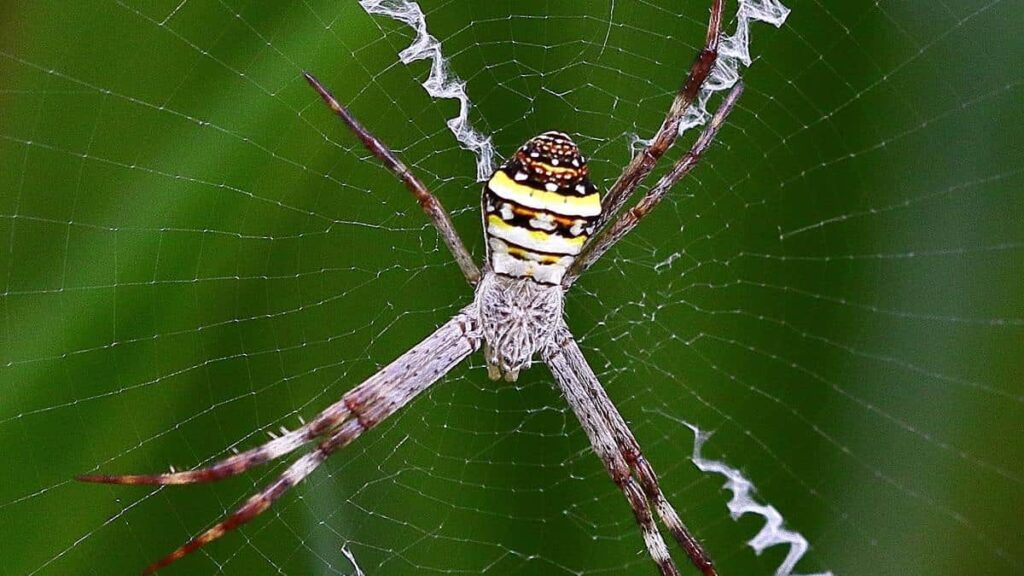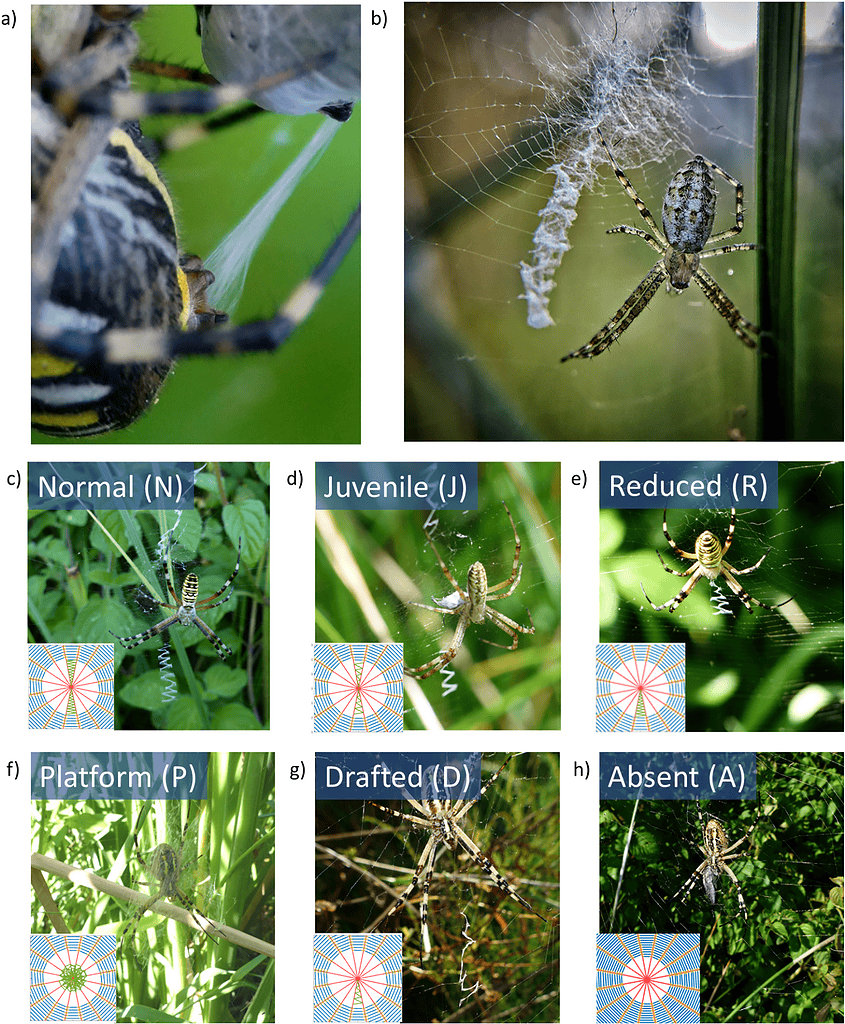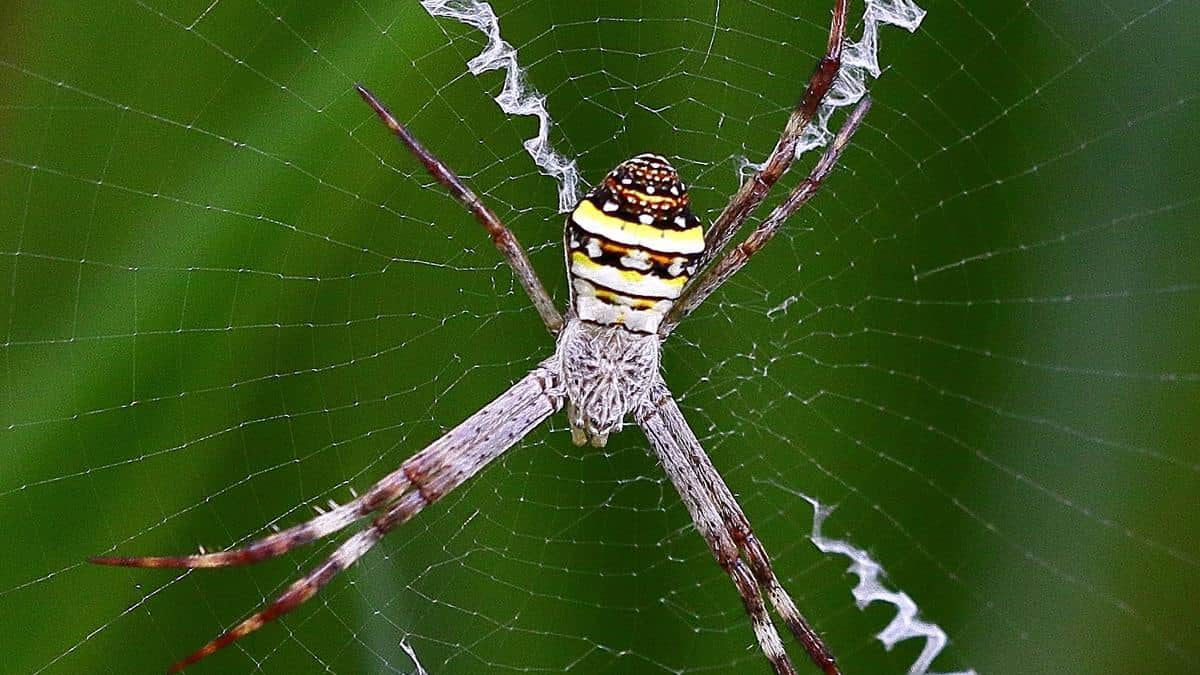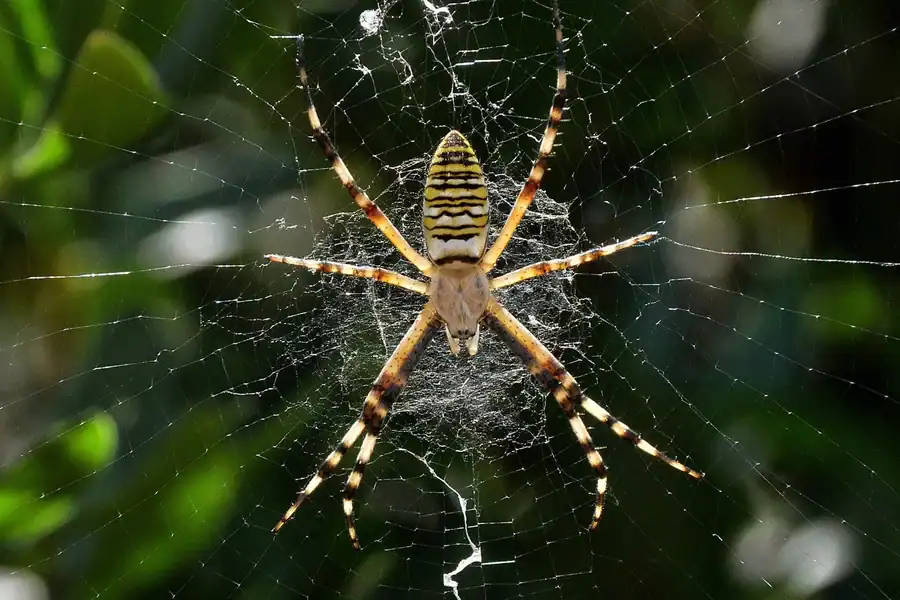 A northern St Andrew’s cross female spider in Australia building a web with X-shaped stabilimenta seen radiating from the centre. Credit: Summerdrought (CC BY-SA)
A northern St Andrew’s cross female spider in Australia building a web with X-shaped stabilimenta seen radiating from the centre. Credit: Summerdrought (CC BY-SA)
After a spider finishes weaving its web, it sometimes adds one last touch. A bright zigzag down the middle, like a silken “X.” These flourishes, known as stabilimenta, have puzzled scientists for a long, long time. Why would a creature that relies on invisibility add something so conspicuous?
A new study led by Gabriele Greco at the Swedish University of Agricultural Sciences may offer a fresh answer: these silk decorations help spiders hear their webs better.
“The stabilimentum, acting as an additional inertial mass, does not significantly slow down the propagation of elastic waves generated by prey impact,” the authors write. “However, when prey impact induces vibrations tangential to the spiral threads of the web, the presence of the stabilimentum enhances the spider’s ability to detect prey location.”
A Decoration with a Purpose
For decades, arachnologists have argued about stabilimenta as if debating some artwork. Were they camouflage? A lure? A sunscreen? The structures — thick, white bands made from a special kind of silk called aciniform — appear in all sorts of patterns and frequencies across species.
“It’s an area that scientists seem to relish fighting over,” Greco joked in an interview with The New York Times. “And I was stupid enough to start this topic.”
Previous ideas were plentiful. Scientists argued that the decorations reflect ultraviolet light to attract insects, collect dew, or deter birds from flying through webs. Some researchers even suggested that stabilimenta might help regulate temperature or serve as a kind of water reservoir. But the new research, combining fieldwork with advanced computer simulations, points toward a mechanical role.
 The stabilimentum in Argiope bruennichi. a) The production of aciniform silk by A. bruennichi when wrapping a prey. b) A juvenile A. bruennichi in the centre of its web with the stabilimentum (courtesy of Letizia Alleruzzo, Aracnofilia – Italian Association of Arachnology). c– h) The different types of stabilimentum observed in the webs: normal (N), juvenile (J), reduced (R), platform (P), drafted (D), and absent (A, i.e., without stabilimentum). Credit: PLOS ONE, 2025.
The stabilimentum in Argiope bruennichi. a) The production of aciniform silk by A. bruennichi when wrapping a prey. b) A juvenile A. bruennichi in the centre of its web with the stabilimentum (courtesy of Letizia Alleruzzo, Aracnofilia – Italian Association of Arachnology). c– h) The different types of stabilimentum observed in the webs: normal (N), juvenile (J), reduced (R), platform (P), drafted (D), and absent (A, i.e., without stabilimentum). Credit: PLOS ONE, 2025.
Greco and his team spent two years in Sardinia photographing wasp spiders (Argiope bruennichi) and their ornate webs. They documented six major stabilimentum shapes: “normal” zigzags extending up and down, “reduced” ones on only one side, “juvenile” and “platform” forms woven thickly across the center, “drafted” versions with thinner lines, and webs with no decoration at all.
The Vibrating World of the Spider
Spiders don’t see their prey so much as feel it. When a fly blunders into a web, its struggle sends ripples along the silken threads. A spider, resting at the center, interprets these vibrations to locate and size up its victim.
“Until now, there wasn’t much scientific investigation into how stabilimenta affected the structure, motion and vibration of webs,” Greco told The Times. So, his team built digital replicas of the webs to see how elastic waves moved across them. They were made with and without stabilimenta.
In the virtual experiments, tiny pulses simulated insects hitting different parts of the web. The model calculated how long vibrations took to reach the spider’s position.
At first, the results were disappointing. “We thought that we would have found something much more evident,” Greco said. But when they simulated sideways, or tangential, vibrations — the kind produced when a trapped insect wriggles along the threads — something changed. The stabilimentum helped transmit those vibrations across the web. Signals that would normally dissipate were now able to reach the spider on the opposite side.
More Dinner Bells
As Scientific American summed it up nicely, “Greco was surprised to find that stabilimenta in the platform shape can play a huge role in transmitting that vibration… a process that, in nature, would help the waiting arachnid detect prey.”
This effect didn’t make vibrations travel dramatically faster — just a few milliseconds quicker — but it expanded the number of “detection points” across the web. The team likened it to giving spiders more doorbells to listen for.
While the gain might sound small, evolution often rewards such subtleties. For a spider that reacts within 30 milliseconds to movement, shaving even a fraction off that time (or detecting a vibration from farther away) could mean the difference between dinner and an empty web.
Fritz Vollrath, an evolutionary biologist at Oxford not involved in the study, cautioned that “the paradox of the stabilimenta has not been resolved.” But even he acknowledged that the study “brings an old idea about stabilimenta — that they affect the stability and other properties of a web — into the modern era.”
From Silk to Sensors
The implications stretch beyond arachnology. The study’s computational models show how structural patterns can influence the way materials transmit energy. Such knowledge could inspire new metamaterials — engineered structures with unusual mechanical or acoustic properties.
“The intricate geometries of spider webs have long inspired the design of hierarchical metamaterials, prized for their unique acoustic properties,” Greco told IFLScience. “The stabilimentum, in particular, demonstrates how decorative silk structures can actively broaden a web’s sensitivity to certain vibration types.”
In other words, those zigzag threads might teach engineers how to design better vibration detectors, pressure sensors, or even soundproofing systems — structures that respond differently depending on the direction or type of wave passing through them.
Todd Blackledge, a spider biologist at the University of Akron who was not involved in the research, told The Times that “the implications might actually be more important for materials research, sensor technology than they are for the real animals.”
The findings appeared in the journal PLOS One.


